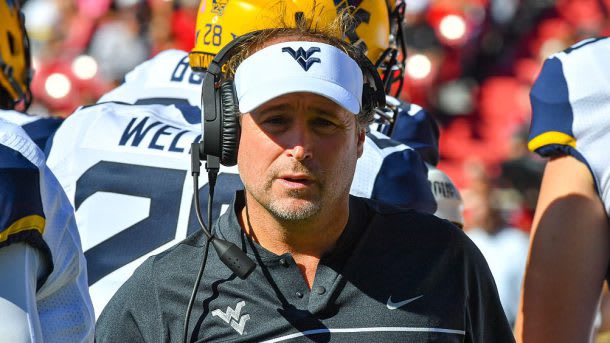For WVU, Holgorsen: running the ball didn't happen overnight

Dana Holgorsen often jokes that he’s been kicked out of the air raid club.
But there is something to the evolution of his offense at West Virginia. It’s a much different look than even six years ago when Holgorsen took the reins in Morgantown. Holgorsen has changed.
That notion of this evolution was only further reinforced when the architect of the pass-happy offense and Holgorsen’s mentor, Hal Humme attended the Mountaineers regular season-finale against Baylor.
The head coach first met Mumme as a player at Iowa Wesleyan, where Mumme was taking his first coaching job. With his arrival, came the introduction of an unorthodox offense at the time focused primarily on passing the football to multiple wide receivers and running backs out of the backfield.
In that aforementioned contest against the Bears, West Virginia completed only 10 passes for 111 yards, while misfiring on 16 other attempts. It was a performance that Holgorsen simply describes as the Mountaineers “not being able to throw the ball at all in that game.”
The pupil’s offense had developed into something quite different than the master’s original plan. But the end result was what mattered and that was a 24-21 win, with over 300-yards on the ground.
“I really, really didn’t want to kick you out but I’m going to have to,” Holgorsen said of the interaction with Mumme following the game.
While it’s a joke, there is definitely something to the change in philosophy during Holgorsen’s time atop the Mountaineers offense.
During his first two seasons, West Virginia had 1,957 total plays with 1,079, or 55-percent of those, coming through the air.
Over the past two campaigns, that has shifted with 1,196, or almost 59-percent, of the total 2,034 plays that were run coming on the ground.
But it didn’t happen overnight.
Holgorsen was introduced to some concepts at Houston with Kevin Sumlin, but started to get immersed in a different style of offense given the personnel at Oklahoma State. There the offense was more centered on the old-school style of lining up with hand in the dirt and a fullback to run the ball.
Things took a step even more when Holgorsen, now the head coach at West Virginia, brought Ron Crook into the program from Stanford with a different mentality to running the ball and gap schemes.
“You can’t just make the decision you’re going to run the ball overnight …” Holgorsen said. “It took us a couple years before we were any good at it and we just continued to improve.”
The success on the ground also attracted better running backs such as senior Justin Crawford, who transferred to the Mountaineers after earning NJCAA offensive player of the year honors. In his first season with the program a year ago, Crawford earned Big 12 Newcomer of the Year rushing for 1,184 yards and averaging over seven yards per tote.
West Virginia will welcome Florida transfer Will Grier as its quarterback this coming season and unlike his predecessor Skyler Howard, the signal caller is a much more refined pocket passer. Expect the Mountaineers to throw the football, but also keep the run game a vital part of the attack.
The two areas will play off one another with running the football opening up passing lanes and vice versa. It’s the offensive balance that any head coach craves.
“We’re going to run the ball that’s what we’re built on and who we are,” he said.
A far cry from Holgorsen’s beginnings and easy to see why the air raid club might now have a missing seat at the table.
